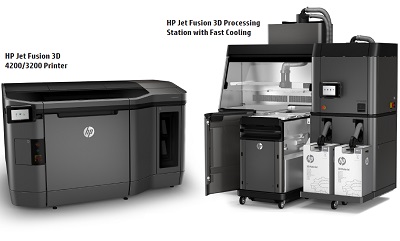The advent of 3D printing being integrated in the overall operations has transformed manufacturing workflows thereby creating premium quality products.
Siemens’ vision to industrialize additive manufacturing yielded an additive manufacturing (AM) software module, Siemens NX AM for HP Multi Jet Fusion. In tandem with HP Inc., the software is part of the Siemens’ end-to-end design to production AM solution. The module allows for the development and management of parts in a single software environment for HP 3D Printing solutions, resulting in avoidance of costly and time-consuming data conversions and third-party tolls, and the improvement of overall design to finished part workflow efficiency. It also includes functionality for build tray preparation and 3D nesting of parts allowing optimization of the economics of a print session by nesting as many parts as possible into the build chamber.
The software model enables customers to combine design, optimization, simulation, preparation of print jobs, and inspection processes for HP Multi Jet Fusion 3D printed parts in a managed environment. Users can now load multiple 3D part models auto nest and submit them (via integrated Materialise capabilities) to an HP 3D printer, all in a single NX environment and with a minimum of steps. The Siemens NX and HP Multi Jet Fusion integration also eliminates the need for data conversion between software applications or process steps and, in the future, is intended to allow unprecedented control, including material characteristics down to the individual voxel-level. This will result in the ability to print parts with variable textures, density, strength and friction, and thermal, electrical, and conductivity characteristics.
From prototyping tool to full production
Siemens’ collaboration with HP went a step further with solutions to transform additive manufacturing from a prototyping tool to full production utilization. The new technology will enable 3D printing of functional production parts that can be made from multiple materials in multiple colors.
This additive manufacturing offering will help drive the new and scalable Multi Jet Fusion™ technology and new HP Jet Fusion 3D printers. This combination enables designers and engineers to create products that go beyond today's production limitations and that can be manufactured at greatly increased speeds using 3D printing. Siemens' additive manufacturing offering will leverage the company's comprehensive end-to-end design to production technology suite. Together with HP Multi Jet Fusion technology it is intended to allow unprecedented print control, including material characteristics down to the voxel-level, at speeds up to ten times faster and at half the cost of current 3D print systems. (A "voxel" is essentially a 3D pixel.)

"Additive manufacturing technology is bringing about an industrial revolution in manufacturing, allowing business to use 3D printing to realize creativity and innovation in product development," said Mr. Chuck Grindstaff, President and Chief Executive Officer, Siemens PLM Software. "HP's new 3D printing technology driven by Siemens' additive manufacturing software will provide engineers a new level of design freedom, customization and speed. Companies will be able develop products that perform better with less weight and more strength. They will be able to print assembly components as one part with varying characteristics, saving time and money while reducing the chance of manufacturing errors. These capabilities will change how parts are made but more importantly how products are envisioned."
In order to make 3D printing a viable production alternative, the technology has to evolve in regards to speed, quality, and cost. Equally important, the data input for 3D printers has to also evolve, making software a critical component. Designers and engineers can only take full advantage of additive manufacturing if they can have control over part and material characteristics down to the voxel-level. This means having the ability to print parts with variable textures, density, strength and friction, as well as electrical and thermal characteristics. Voxel–level control at the printer could have a massive influence on what designers and engineers can do with product innovation and manufacturing.
"For customers to take full advantage of HP's new Multi Jet Fusion technology's ability to control material and part characteristics at the voxel level, CAD/CAM/CAE systems have to support advanced design and analysis techniques," said Stephen Nigro, president of HP's 3D printing business. "Siemens software expertise in product lifecycle management combined with HP innovation will help elevate 3D printing from a prototyping solution into production."
Siemens' goal is the industrialization of additive manufacturing. With a comprehensive offering that covers PLM software, integrated automation and manufacturing operations management Siemens supports machine builders and manufacturers to establish 3D printing as an integral production process.
Nike HyperRev 2017













